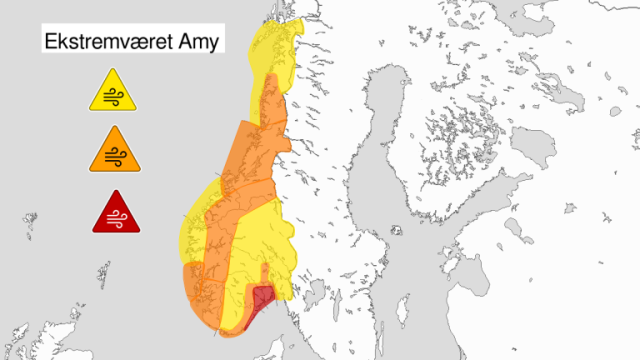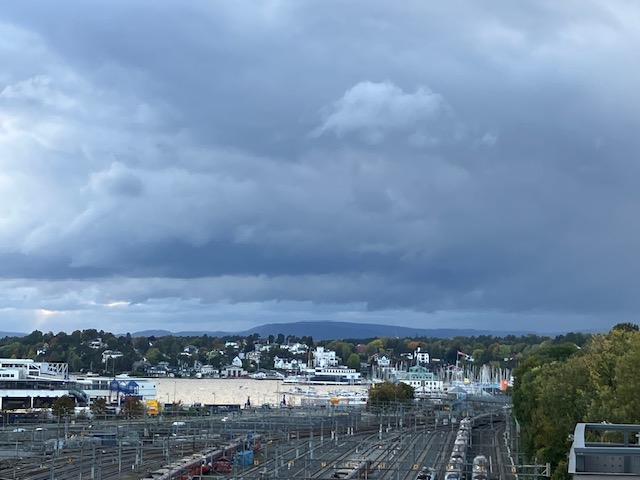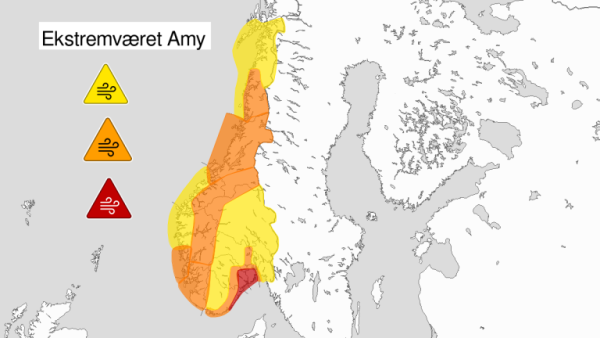More than 117,000 households were without electricity and around 170 roads were closed by fallen trees and landslides on Saturday afternoon, after the extreme storm ‘Amy’ slammed into both central- and southern Norway during the night. Flood- and landslide warnings have been extended up to Nordland County and authorities were urging as many as possible to refrain from driving.
 The extreme weather system dubbed “Amy” was initially expected to hit Norway’s southeastern coast the hardest, with “Code Red” warnings posted between Kristiansand and up towards Oslo. The storm, however, also spread much farther north along the west coast, causing lots of damage from Stavanger and Bergen up to Trondheim and beyond. MAP: Norges Meteorologisk Institutt
The extreme weather system dubbed “Amy” was initially expected to hit Norway’s southeastern coast the hardest, with “Code Red” warnings posted between Kristiansand and up towards Oslo. The storm, however, also spread much farther north along the west coast, causing lots of damage from Stavanger and Bergen up to Trondheim and beyond. MAP: Norges Meteorologisk Institutt
Ferries remained cancelled, as were all trains running on the lines between Oslo, Kristiansand and Stavanger. Rail lines over the mountains of Dovrefjell between Oslo and Trondheim were also shut down and emergency crews were unable to keep up with demand for help in several communities in the county of Møre og Romsdal.
Storm warnings had been posted, as the remains of “Hurricane Humberto” in the Caribbean moved over the Atlantic and turned into the extreme weather dubbed “Amy” in the UK. It hit Ireland hard before moving on over the North Sea and plowing into Norway Friday night.
Initial warnings predicted that the most dangerous impact would be along the southern coast known as Sørlandet, between Kristiansand and up towards Oslo. By Saturday morning, however, the storm had also hit the west coast hard and moved on up to Trondheim and beyond. Roofs were torn off homes, trees were uprooted and the strong winds damaged several buildings and homes in Oppdal to the east of Dovrefjell.
 This was the scene over western Oslo as the storm approached late Friday afternoon. On Saturday the Norwegian capital was battered by heavy rain and strong winds all day and well into the evening, but there was no loss of power. PHOTO: NewsinEnglish.no/Nina Berglund
This was the scene over western Oslo as the storm approached late Friday afternoon. On Saturday the Norwegian capital was battered by heavy rain and strong winds all day and well into the evening, but there was no loss of power. PHOTO: NewsinEnglish.no/Nina Berglund
Several areas also lost not only electricity but all internet- and mobile phone coverage. The counties of Trøndelag, Agder and Vestland were hit the hardest, but strong winds and heavy, relentless rain extended east to Oslo and farther north into Hadeland and Innland County. The historic mining town of Røros, near the Swedish border, was completely without power by Saturday evening.
The storm hit just as thousands of Norwegians are on traditional autumn holidays, when schools close for a week, and many had traveled to cabins in the mountains. The holidays were ending for some and beginning for others this weekend, and that caused problems for everyone with electric cars. They couldn’t recharge in areas where power had been knocked out.
The heavy rain, manwhile, was beginning to spark flooding along rivers and streams throughout Southern Norway. Police reported Saturday evening that 27 people had to be evacuated in Notodden when water levels in the local river and lake rose to dangerously high levels. Storm warnings were to remain in force through the weekend.
The counties of Telemark and Vestfold were also hit hard by the storm and 17,000 households lost power. “This is a situation we haven’t experienced before,” Thor Bjørn Omnes of the local electric utility Lede told Norwegian Broadcasting (NRK). “It’s exceptional.” Meteorologists predicted as much as 100mm of rain in the region with winds clocked at 36 meters per second. That was enough to loosen boats from their moorings in Sandefjord, Tønsberg and other harbours along the coast.
The storm had been billed as possibly the hardest to hit Norway in the past 25 years. State meteorologists said the worst of the wind and rain was beginning to let up in Southern- and Eastern Norway but kept moving north from Trøndelag. Warnings were raised to the “orange” level along the scenic Helgeland Coast that extends north to Bodø. It was also snowing at high elevations.
NewsinEnglish.no/Nina Berglund
